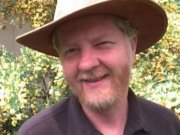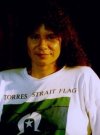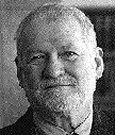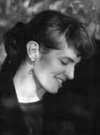Thylazine: The Australian Journal of Arts, Ethics & Literature #4/thyla4h
SEVEN AUSTRALIAN POETS
Mark O'Connor, Dorothy Porter, Anthony Lawrence, Lisa Bellear, Thomas Shapcott, Tracy Ryan, Ron Pretty
Interviewed by John Kinsella







Mark O'Connor

|
I tend to write poems that I think are necessary. I'd like Australians to see the variety of the natural world, and not class it all as just bush. I don't believe there is any single "nature feeling", but many different ones. Standing at the cliff edge at Kanangra Walls or staring up at the canopy at Minnamurra, there can be a sudden rush of euphoria, or of vertigo. But for me, more often, or in more places, there's a quieter more pervasive pleasure in being there - in the interestingness of it, the rightness, and the variety of it all. It's hard to tell whether this is, as some people ... |
[Above] Photo of Mark O'Connor by Ron Evans, 1999.
Dorothy Porter

|
Not really. In my earliest days as a writer I was very much influenced by the romantic image of the poet, hence I waited for inspiration to strike like the proverbial lightning. This idea is not congenial with shaping poems in terms of "a book". I had nothing like that kind of discipline - or ambition. But I have always been interested in narrative poetry and exploring characters and extreme scenarios through poetry. Recently re-reading my first collection LITTLE HOODLUM I realised how much I was influenced by the dramatic monologues of Browning and Eliot, and how often the voice of my own early monologues was male. These ... |
[Above] Dorothy Porter and Emma by Andrea Goldsmith, 1996.
Anthony Lawrence

|
I've always thought of Dramatic monologues as having a curious duality. They give poets a vehicle in/from which to define themselves through the voices of others, and to let pure invention have its head. Autobiography? There have certainly been poems (dramatic monologues and shorter, lyrical poems) where aspects of my life have been worked through. Though mostly it's a case of the imagination staking out new territory to explore. Every voice contains a vein of experience. Some voices work this more than others. I think it's dangerous to anticipate personal experience in all genres. I've never thought of myself as someone who "... does my experience over in verse" as Robert ... |
[Above] Photo of Anthony Lawrence by Jenni Mitchell, 2000.
Lisa Bellear

|
My immediate answer is yes, however it is important not to view language solely from a Western Eurocentric position, particularly when dealing with a colonised country like Australia. The invaders chose not to see "language" "symbols" "culture/s" "lores/laws" of Indigenous Australian's. As a result this lack of seeing, acknowledging led to the deliberate destruction of hundreds of Indigenous languages, tribes, clans. As a poet/writer/photographer who identifies as Indigenous, I must express my frustration at being forced to communicate in the coloniser's language: English. A further complication is how often our identity as Indigenous people is devalued by some ... |
[Above] Photo of Lisa Bellear by Jenni Mitchell, 1999.
Thomas Shapcott

|
I was born and grew up in Ipswich, Queensland, Australia, a mining-industrial town 25 miles inland from Brisbane. Our house was on a hill and on the other side of that hill was a wilderness. It had once been mined but in 1941 (when I was 6) the mine caught fire and it was closed down. We played games in that area and had gangs who roamed among the secondary growth timber and came upon the smoke seeping out from the limestone rocks. The area was actually used by the University of Queensland as a fossil site. So though it was a shabby industrial town it had its magic for a kid. I was the 3rd of 4 sons (no sisters) and a twin. Jack and I were fraternal twins and in ... |
[Above] Photo of Thomas Shapcott by Mark Fitz-Gerald, 1999.
Tracy Ryan

|
I don't think my sensibilities are much like hers. I can't help but be influenced by her work, but I'm influenced by many other poets too. I think there is plenty that's admirable in her poetry, but there are limitations to it as well. I admire her formal control, her talent for the image, her ability to take risks - also her breadth of reading, even if that came from compulsive ambition (and a Cambridge education!). If you think of the stuff that's common in Plath (recurrent imagery of moon, tree, blood, babies etc), just on that simple level I can't see any resemblance at all. I'm not as much of a formalist as Plath. As you know, I'm not at all driven. I don't have her technical flair or bent ... |
[Above] Photo of Tracy Ryan by Wendy J. Kinsella, 1998.
Ron Pretty

|
I dabbled as a child and a teenager, the first piece I can remember publishing was in the school magazine when I was in Year 7. When I went to Sydney University I fell in love with W B Yeats and wrote bad imitations of him for years. But I wasn’t writing seriously until, in 1969, I went to Greece for a year. I spoke no Greek when I went there, and there were no English speakers in Serrai, the town in Greek Macedonia I was based in. As a result, I wrote endlessly in the course of that year, and began to take my writing seriously. I also discovered Seferis, Cavafy, Theodorakis (his Matthausen song cycle stays with me), Kazantzakis and co. Living in Greece under the dictator, ... |
[Above] Photo of Ron Pretty by Chris Verheyden, 1998.
I Next I
Back I
Exit I
Thylazine No.4 (September, 2001) | |



